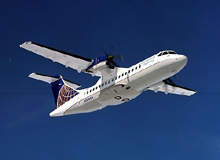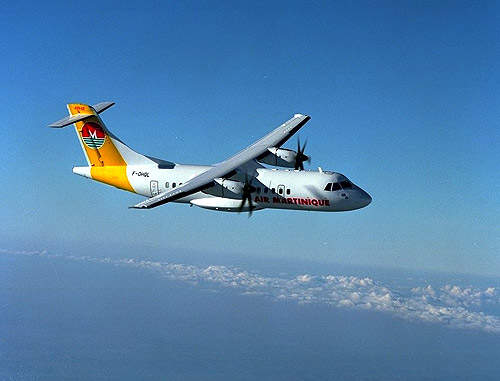The ATR 42-500 is one of a family of twin turboprop passenger aircraft developed and manufactured by Avions de Transport Regional (ATR). ATR, with headquarters in Toulouse, is a joint venture company between EADS and Finmeccanica / Alenia Aeronautica.
The family consists of the ATR 42 and ATR 72, of which the ATR 42-500, ATR 42-600, ATR 72-500 and ATR 72-600 are the models currently in production.
The 500 series new generation aircraft is equipped with new engines, new propellers, improved hot and high performance, increased weight capacity and an improved passenger cabin. The 50-seat ATR 42-500 was first certificated in July 1995.
As of December 2011, ATR had received orders for 1,074 aircraft and 927 aircraft were delivered (ATR 42 – 423 ordered and 412 delivered, ATR 72 – 651 ordered and 503 delivered, and others 12 delivered). The ATR aircraft are in service with 165 operators in 92 countries.
The orders for the ATR 42 include: Finncomm Airlines (eight plus eight options), Air Caledonie (two) and Air Madagascar (one), placed in June 2005, Pakistan International Airlines (seven), placed in November 2005 and Precision Air of Tanzania (three) in August 2006. In July 2010, Nordic Aviation Captial awarded a contract to ATR for seven ATR-42 aircraft. ATR 42-500 was delivered to NordStar Airlines in March 2011.
In October 2007, ATR launched the new 600 series of ATR 42 and ATR 72 aircraft. The new aircraft is equipped with a Thales Avionics glass cockpit, new PW 127 M engine and light-emitting diode (LED) lighting in the cabin.
The flight test campaign of the ATR 42-600 series aircraft began in March 2010. The ATR 42-600 and ATR 72-600 aircraft are undergoing flight trials. The new ATR 600 series will enter into the service of Royal Air Maroc in 2012.
ATR-72-600 was certified by European Aviation Safety Agency (EASA) in May 2011. Two of the first ATR 72-600 aircraft were delivered to Royal Air Maroc in August 2011. Caribbean Airlines received the first delivery of ATR 72-600 aircraft in November 2011.
A variant for maritime patrol, the ATR 42MP Surveyor, is in service with the Italian Guardia di Finanza (three aircraft) and coastguard (two aircraft).
The Surveyor can be fitted with search radar, a Galileo Avionica mission system, Elettronica electronic support measures (ESM), forward-looking infrared (FLIR) and a TV camera. The aircraft can spend up to eight hours on station, at 200nm from base.
In June 2007, Nigeria ordered two 42MP variants. The first ATR-42MP was delivered to the Nigerian Air Force in December 2009. The second was delivered in March 2010. Libya ordered one in January 2008 and the Italian coastguard ordered one additional aircraft in February 2008.
The ATR 42-500 is certified to operate on unpaved runways through installation of a kit to ensure landing gear and lower fuselage protection. Special cold weather procedures allow operation down to temperatures of -54°C.
The ATR aircraft family is certified for low external noise performance according to FAR Part 36 and CH.3 ICAO Annex 16, ensuring compliance well within the current and CH.4 noise regulations.
ATR 42 aircraft design features, flight deck and avionics systems
The aircraft is a high-wing monoplane with a semi-monocoque fail-safe fuselage built of light alloy. Composite materials, such as carbon monolithic structure, carbon / Nomex sandwich and Kevlar / Nomex sandwich, are extensively used and represent 19% of the total weight of the structure.
Alenia Aeronautica is responsible for the manufacture of fuselage, tail units and installation of landing gear.
The wings are manufactured and tested at EADS Sogerma, in Bordeaux. ATR has full responsibility for final assembly and delivery to customers.
Standard navigation systems satisfy the latest rules and safety requirement, including CAT I AFCS. The ATR aircraft are certified for CAT II ILS operations (80ft decision height), available as option.
The ATR navigation system is based on the Honeywell Trimble HT1000 global navigation satellite sensor (GNSS). The HT1000 GNSS system is coupled with the auto-pilot, the electronic flight instrumentation system (EFIS) and with VHF omnidirectional radio ranging steering guidance with distance measuring equipment data (VOR/DME).
The aircraft is equipped with a Rockwell Collins TTR 921 radar for ACAS II. A Honeywell Primus 660 colour weather radar displays in four colours on the electronic horizontal situation indicator (EHSI). Weather radar can also be used in MAP mode to display ground obstacles. The Honeywell MARK VIII enhanced ground proximity warning system (E-GPWS) integrates a terrain awareness alerting and display, plus a terrain floor clearance on the electronic flight information system (EFIS).
In October 2007, Thales Avionics was selected to provide the digital avionics suite for the ATR 42-600 and ATR 72-600 aircraft. The suite includes five LCD displays, a new flight management system, new communications, new navigation systems with global navigation satellite system / wide-area augmentation system (GNSS / WAAS) and new automatic pilot for CAT III approaches.
ATR series aircraft cabin
The ATR 42-500 can carry up to 50 passengers in a four abreast, centre-aisle configuration. The standard configuration includes two cargo compartments.
The front 4.8m³ cargo compartment is between the flight deck and passenger cabin and the 4.8m³ rear compartment is to the rear of the passenger cabin.
Quick change kit
ATR has developed a quick change kit which provides the capability to reconfigure the cabin in 30 minutes to carry ATR-specific containers using the standard front cargo door.
The kit allows the aircraft to be operated as a passenger plane during the day and as a cargo plane during the night. Each optimised container has a 2.8m³ volume and can carry freight up to a total weight of 500kg. ATR 42 can carry up to nine ATR containers.
Cargo conversion kit and engines
Alenia is responsible for the design of the cargo conversion kit which converts the aircraft to a freighter. Aeronavali, a subsidiary of Alenia, is the selected outfitter for the aircraft.
The 1.52m×1.27m front standard cargo door can be replaced with a 2.95m×1.8m large cargo door to carry standard unit load device (ULD) containers, such as LD3 and 88in×108in containers.
ATR 42 can carry five LD3 containers plus 10.0m³ of bulk freight. An alternative load arrangement comprises three 88in×108in containers, one 63in×88in container and an additional 11.9m³ of bulk freight.
At present, 30 ATR cargo are in service with 12 operators, while 27 ATR 42-320 for FedEx are under conversion. Only two of these aircraft have been equipped with the large cargo door: one ATR 72 operated by Farnair and one ATR 42 flown by Northern Air Cargo Alaska. The FedEx aircraft are equipped with the standard cargo door.
All ATR series aircraft are powered by two Pratt & Whitney Canada PWC 100 Series engines. The ATR 42-500 is powered by two PWC 127Es.
The thermodynamic power, under maximum continuous conditions, is 2,315kW (3,148eshp) and the mechanical power is 1,765kW (2,400shp) for each engine, available up to 45°C.
The propellers are two six-bladed Hamilton Sundstrand 568F propellers with Propeller Electronic Control. Blades are all-composite counterweighted. The pinner is aluminium, while engine cowlings are made in carbon / Nomex sandwich or in Kevlar / Nomex sandwich. The engine intakes are in Kevlar / Nomex sandwich with stiffening carbon plies.
The two integral fuel tanks can carry 5,700l of fuel.
A pneumatic de-icing system is provided for the engine air intakes, wing leading edge and horizontal tailplane leading edge. An electrical anti-icing system is installed for the propeller blades, windshields and horns.
Landing gear onboard the ATR aircraft
The aircraft has a hydraulically retractable tricycle landing gear. The landing gear legs are provided by Messier, wheels and brakes by Dunlop, antiskid control by Crane Hydro-Aire and tyres by Michelin (or optionally Goodyear tyres for operations on unpaved runways).
A Magnaghi hydraulic system provides landing gear retraction and also serves other systems in the aircraft.









